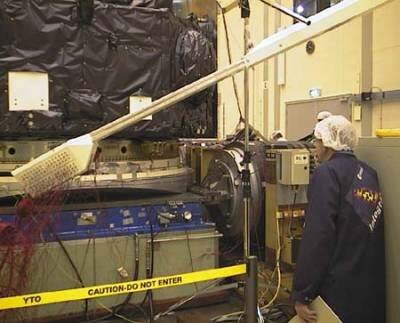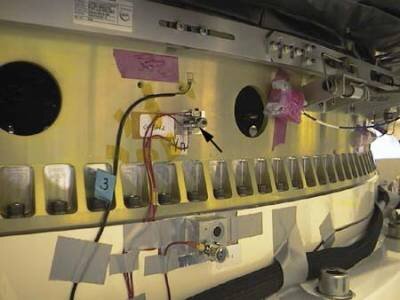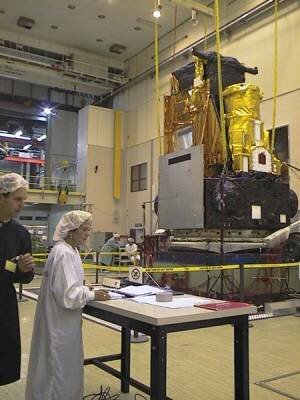Whole lot of shakin' goin' on!
Spacecraft are built to be as sturdy and as light as possible but their ride into space can be a bit rough. To ensure they will survive the launch and function as planned in orbit, all satellites are submitted to strenuous vibration tests before launch.
The INTEGRAL spacecraft was delivered to ESA in July and is undergoing a series of environmental tests at the European Space Agency's testing facility (ESTEC) in Noordwijk, the Netherlands. It is currently being put through its paces on a powerful 'shaker'. No one would like to stand on this when it goes into action!

"We validated the INTEGRAL design and compatibility with the launcher using a structural model of the spacecraft," explains Eliseo Balaguer, ESA's assembly, integration and verification (AIV) manager for the mission. "But that was just a piece of metal, with no life inside."
"Now it is the real fully functional flight satellite, with two of its four science instruments installed. The remaining JEM-X and IBIS instruments are represented by equivalent masses. Likewise we have dummy solar-arrays. Apart from this, we are shaking the satellite precisely as it will be configured for launch on its Proton rocket in October 2002."
A hi-fi with a 2 kilowatt woofer!

The mechanical shaker can work in two modes: when it functions laterally, it is a horizontal metal slab that can move on an oil cushion, and to which the spacecraft, in this case INTEGRAL on its launcher adapter, is bolted. The actual vibratory mechanism, placed on one side, is composed of two big coils - like giant electric buzzers - which can exert a total force of 32 tonnes. The shaker can also work vertically in which case the coils are placed under a structure resembling a huge Camembert cheese.
The spacecraft is much like a patient who is being monitored before an operation: 240 monitors (three-axis accelerometers which can measure the smallest movement) have been placed everywhere inside it. The black and gold coloured INTEGRAL stands proudly but it suffers the indignity of many spaghetti-like red cables which link it to the control room.
"This electro-dynamic test table can be compared to a domestic loudspeaker," says Jean-Pierre Vessaz, ESTEC's test manager. "We start with very low frequency (5 Hertz) vibrations which are visible but inaudible, and go up to 150 Hz. Your hi-fi installation can have, say, 100 watts; here we inject the equivalent of 2000 watts into the satellite." (The spacecraft will in due course undergo another series of acoustic tests at much higher frequencies, up to 20 000 Hz).
60 seconds of shimmering vibrations

The shake we are about to watch is being conducted by Monica Durante, a member of the Alenia Spazio team, INTEGRAL's prime contractor. She is nearing the end of her checklist and asks everyone in the clean room to be quiet. Four visual observers take up their positions. A digital display on the wall signals that the shaker has started a 'self-check'.
The test begins silently, almost imperceptibly. Only the wall display betrays that INTEGRAL is beginning to vibrate. Then one clearly sees the 4-tonne spacecraft gently sliding back and forth, a displacement of just 7 millimetres. The numbers on the wall increase in steps and the golden thermal insulation starts shimmering.
The vibration becomes audible, a low rumble like a distant passing train. INTEGRAL's upper surfaces are now definitely wobbling like jelly. The sound increases, and the low-pitch whine modulates, reminiscent of an early jet engine revving up.
The noise ceases abruptly, and in silence the engineers and spectators smile at each other. Someone claps, expressing everyone's satisfaction. The display shows '150 Hz' and the test has lasted only 60 seconds. None of the eleven test runs to be carried out during these two and a half weeks will exceed two minutes.
"It will take about an hour for all the information from the accelerometers to be ready for analysis," says Eliseo Balaguer. "But the Alenia and ESTEC engineers will be scrutinising these data late into the night, making sure that INTEGRAL is resisting as we expect, so that we can proceed with the following test."
"Submitting a spacecraft to this torture is indispensable," says Jean-Pierre Vessaz. "When everything has been done as planned, nothing unexpected happens during these acceptance tests. But in the past on other missions, problems such as fractures and insufficiently tightened bolts have been identified. And everyone prefers to discover such things well before the launch day!"
In October, when the mechanical vibrations tests are completed, the JEM-X instruments are due to be integrated with the spacecraft. The remaining IBIS instrument is due to be delivered in November. Both instruments will have been submitted to their own dose of shaker tests.




